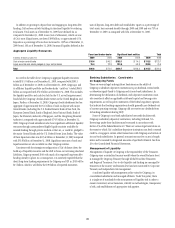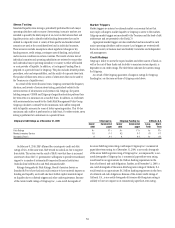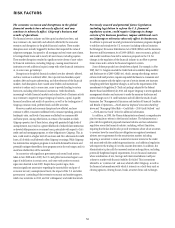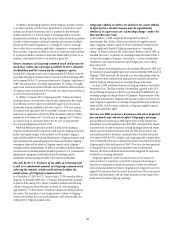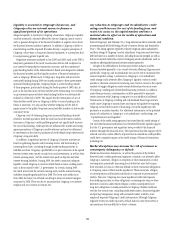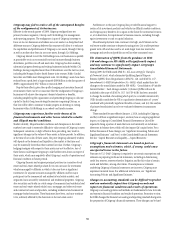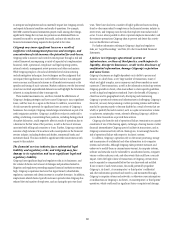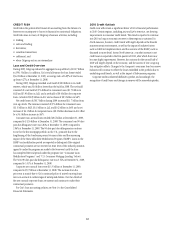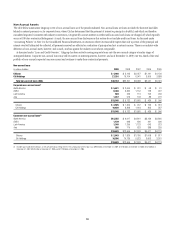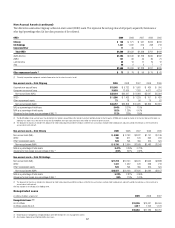Citibank 2009 Annual Report Download - page 69
Download and view the complete annual report
Please find page 69 of the 2009 Citibank annual report below. You can navigate through the pages in the report by either clicking on the pages listed below, or by using the keyword search tool below to find specific information within the annual report.59
Citigroup may fail to realize all of the anticipated benefits
of the realignment of its businesses.
Effective in the second quarter of 2009, Citigroup realigned into two
primary business segments, Citicorp and Citi Holdings, for management
and reporting purposes. The realignment is part of Citigroup’s strategy to
focus on its core businesses and reduce non-core assets in a disciplined and
deliberate manner. Citigroup believes this structure will allow it to enhance
the capabilities and performance of Citigroup’s core assets, through Citicorp,
as well as realize value from its non-core assets, through Citi Holdings.
Citigroup intends to exit the Citi Holdings non-core businesses as quickly
as practicable yet in an economically rational manner through business
divestitures, portfolio run-off and asset sales. Citigroup has been making
substantial progress divesting and exiting businesses included within Citi
Holdings, having completed more than 20 divestitures over the last two years,
including the Morgan Stanley Smith Barney joint venture, Nikko Cordial
Securities and Nikko Asset Management sales. Citi Holdings’ assets have been
reduced from a peak level of approximately $898 billion in the first quarter of
2008 to approximately $547 billion at year-end 2009.
Despite these efforts, given the rapidly changing and uncertain financial
environment, there can be no assurance that the realignment of Citigroup’s
businesses will achieve the company’s desired objectives or benefits,
including simplifying the organization and permitting Citigroup to allocate
capital to fund its long-term strategic businesses comprising Citicorp, or
that Citi will be able to continue to make progress in divesting or exiting
businesses within Citi Holdings in an orderly and timely manner.
Citigroup may experience further write-downs of its
financial instruments and other losses related to volatile
and illiquid market conditions.
Market volatility, illiquid market conditions and disruptions in the credit
markets have made it extremely difficult to value certain of Citigroup’s assets.
Subsequent valuations, in light of factors then prevailing, may result in
significant changes in the values of these assets in future periods. In addition,
at the time of any sales of these assets, the price Citigroup ultimately realizes
will depend on the demand and liquidity in the market at that time and
may be materially lower than their current fair value. Further, Citigroup’s
hedging strategies with respect to these assets may not be effective. Any of
these factors could require Citigroup to take further write-downs in respect of
these assets, which may negatively affect Citigroup’s results of operations and
financial condition in future periods.
Citigroup finances and acquires principal positions in a number of real
estate and real-estate-related products for its own account, for investment
vehicles managed by affiliates in which it also may have a significant
investment, for separate accounts managed by affiliates and for major
participants in the commercial and residential real estate markets, and
originates loans secured by commercial and residential properties. Citigroup
also securitizes and trades in a wide range of commercial and residential real
estate and real-estate-related whole loans, mortgages and other real estate
and commercial assets and products, including residential and commercial
mortgage-backed securities. These businesses have been, and may continue
to be, adversely affected by the downturn in the real estate sector.
Furthermore, in the past, Citigroup has provided financial support to
certain of its investment products and vehicles in difficult market conditions,
and Citigroup may decide to do so again in the future for contractual reasons
or, at its discretion, for reputational or business reasons, including through
equity investments or cash or capital infusions.
Should unemployment rates continue to be high, and if stresses in the
real estate market continue to depress housing prices, Citi could experience
greater write-offs and also need to set aside larger loan loss reserves for
mortgage and credit card portfolios as well as other consumer loans.
The elimination of QSPEs from the guidance in SFAS
140 and changes in FIN 46(R) will significantly impact,
and may continue to significantly impact, Citigroup’s
Consolidated Financial Statements.
During 2009, the FASB issued SFAS No. 166, Accounting for Transfers
of Financial Assets, which eliminates Qualifying Special Purpose
Entities (QSPEs) from the guidance in SFAS No. 140, and SFAS No. 167,
Amendments to FASB Interpretation No. 46(R), which makes three key
changes to the consolidation model in FIN 46(R), “Consolidation of Variable
Interest Entities”. Such changes include: (i) former QSPEs will now be
included in the scope of SFAS No. 167; (ii) FIN 46(R) has been amended
to change the method of analyzing which party to a variable interest entity
(VIE) should consolidate the VIE to a qualitative determination of “power”
combined with potentially significant benefits or losses; and (iii) the analysis
of primary beneficiaries has to be re-evaluated whenever circumstances
change.
These standards became effective January 1, 2010, including for Citigroup,
and they will have a significant impact, and may have an ongoing significant
impact, on Citigroup’s Consolidated Financial Statements as Citi will be
required to bring a portion of assets that were not historically on its balance
sheet onto its balance sheet, which will also impact Citi’s capital ratios. For a
further discussion of these changes, see “Significant Accounting Policies and
Significant Estimates” and Note 1 to the Consolidated Financial Statements.
See also “Capital Resources and Liquidity—Capital Resources.”
Citigroup’s financial statements are based in part on
assumptions and estimates, which, if wrong, could cause
unexpected losses in the future.
Pursuant to U.S. GAAP, Citigroup is required to use certain assumptions and
estimates in preparing its financial statements, including in determining
credit loss reserves, reserves related to litigation and the fair value of certain
assets and liabilities, among other items. If assumptions or estimates
underlying Citigroup’s financial statements are incorrect, Citigroup may
experience material losses. For additional information, see “Significant
Accounting Policies and Significant Estimates.”
Changes in accounting standards can be difficult to predict
and can materially impact how Citigroup records and
reports its financial condition and results of operations.
Citigroup’s accounting policies and methods are fundamental to how it records
and reports its financial condition and results of operations. From time to time,
the FASB changes the financial accounting and reporting standards that govern
the preparation of Citigroup’s financial statements. These changes can be hard


